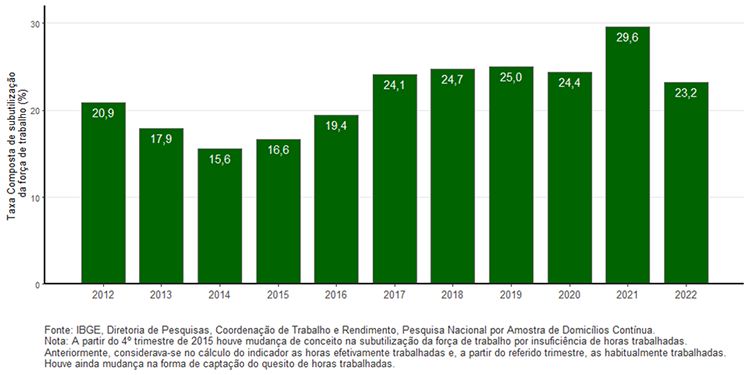Continuous PNAD: unemployment rate hits 11.1% and underutilization rate, 23.2%, in the quarter ended March
April 29, 2022 09h00 AM | Last Updated: April 29, 2022 08h53 PM
| Indicator/Period | Jan-Feb-Mar 2022 | Dec-Nov-Oct 2021 | Jan-Feb-Mar 2021 |
|---|---|---|---|
| Unemployment rate | 11.1% | 11.1% | 14.9% |
| Underutilization rate | 23.2% | 24.3% | 29.6% |
| Usual real earnings | R$ 2,548 | 2,510 | R$ 2,789 |
| Change of usual earnings in relation to: | 1.5% | -8.7% | |
The unemployment rate (11.1%) of the quarter January-March 2022 was stable against the previous quarter (11.1%) and fell 3.8 p.p. against the same quarter in 2021 (14.9%).
The unemployed population (11.9 million persons) was stable against the quarter October-December 2021 (12.0 million persons) and fell 21.7% (by 3.3 million persons) from the same moving quarter in 2021 (15.3 million persons).
Theemployed population(95.3 million persons) fell 0.5% (by 472 thousand persons) against the previous quarter and increased 9.4% (8.2 million persons) against the same period in 2020.
The employment-population ratio (percentage of employed persons in the population at working age) was estimated at 55.2%, with a decreaase of 0.4 percentage points from the previous month (55.6%) and an increase of 4.3 p.p in comparison with the same period a year ago (50.9%).
The composite underutilization rate (23.2%) fell 1.1 p.p. in relation to the previous quarter (24.3%) and 6.4 p.p. against the same quarter in 2021 (29.6%).
The underutilized population (26.8 million persons) fell 5.4% (by 1.5 million persons) from the previous quarter (28.3 million persons) and 20.3% (6.8 million persons) in comparison with the same quarter in 2021 (33.7 million underutilized workers).
The time-related underemployed population (6.5 million) fell by 11.7% against the previous quarter (a decrease of 860 thousand persons) and by 8.2% against the same quarter in 2021, when there were 7.1 million underemployed persons.
The population out of the workforce (65.5 million persons) increased 1.4% (by 929 thousand persons) from the previous quarter and fell 4.8% (by 3.3 million persons) in the year.
The discouraged population (4.6 million persons) decreased 4.1% (by 195 thousand persons) against the previous quarter and 22.4% (by 1.3 million persons) against the same quarter in 2021.
The percentage of discouraged persons in the workforce (4.1%) was stable against the previous quarter (4.3%) and decreased 1.4 p.p against the same quarter in 2021 (5.5%).
The number of workers with a formal employment contract in the private sector (except domestic workers) was 34.9 million persons, having increased 1.1% (by 380 thousand persons) against the previous quarter and 10.7% (3.4 million persons more) against 2020.
The number of workers without a formal employment contract in the private sector (12.2 million persons) was stable against the previous quarter and increased 19.3% (2 million persons) against the same period in 2021.
The number of self-employed workers (25.3 million persons) fell 2.5% in comparison with the previous quarter (by 660 thousand persons) and increased 7.3% (by 1.7 million persons) agaisnt the same period a year ago.
The number of domestic workers (5.6 million persons) remained stable in the quarter and increased 19.0% (895 thousand persons) in the year.
The informality rate was 40.1% of the employed population or 38.2 million informal workers. That rate had been 40.7% in the quarter October-December and, in the same quarter of 2021, 39.1%.
Usual real earnings (R$ 2,548) increased by 1.5% against the previous quarter and decreased by 8.7% in relation to the same quarter in 2021. The usual real wage bill (R$237.7billion) did not record statistically significant changes in either comparisons.
Unemployment rate - Brazil - 2012/2022

In the moving quarter January-March 2022, workforce (employed and unemployed persons) hit 107.2 million, with a decrease of 0.5% (by 534 thousand persons) from the quarter October-December and an increase of 4.8% (by 4.9 million persons) in relation to the same quarter in 2021.
Average usual real earnings recorded increase in the categories Agriculture, livestock, forestry, fishing and aquaculture (6.0%, or R$ 93), Industry (2.9%, or R$ 71), Construction (6.1%, or R$ 117), Trade, repair of motor vehicles and motorcycles (3.2%, or R$ 65) Lodging and feeding (5.6%, or R$ 90) and Domestic services (3.1%, or R$ 30). The other groups did not record significant changes. Against the same quarter in 2021, there was increase in the category Construction (5.8% or more R$ 113) and a decrease in Industry (7.3% or R$ 198) and Public administration, defense, social security, education, human health and social services (15.7%, or R$ 671).
In the comparison by quarter, only two categories in terms of employment status recorded increases: Workers with a formal contract in the private sector (2.3%, or R$ 55) and Domestic worker (3.1%, or R$ 30). The other groups did not record significant changes. The comparison with the quarter January - March 2021 showed there was no growth in any of the categories.
Composite underutilization rate - Quarter from January to March - Brazil - 2012 to 2022 (%)

Employed population by group of activities - quarter ended March
Against the previous moving quarter, the analysys of employed persons showed there was no increase in any group of activity The group of Construction decreased (by 3.4%, or 252 thousand persons).
Against the quarter January-March 2021 there was an increase in the following groups: General industry (8.2%, or 931 thousand persons), Construction (12.7%, or 815 thousand persons), Trade, repair of motor vehicles and motorcycles (12.2%, or 2.0 million persons), Transportation, storage and mailing (10.4%, or 469 thousand persons), Lodging and feeding (32.5%, or 1.3 million persons), Information, Communication and Financial, Real Estate, Professional and Adminstrative Activities (4.0%, or 439 thousand persons), Other services (19.5%, or 811 thousand persons) and Domestic services (19.4%, or 921 thousand persons). The other groups did not record significant changes.

